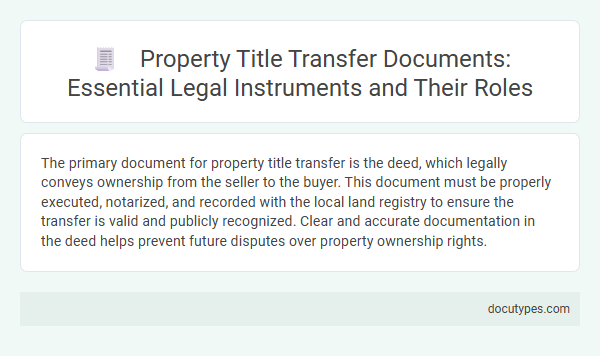The primary document for property title transfer is the deed, which legally conveys ownership from the seller to the buyer. This document must be properly executed, notarized, and recorded with the local land registry to ensure the transfer is valid and publicly recognized. Clear and accurate documentation in the deed helps prevent future disputes over property ownership rights.
Introduction to Property Title Transfer Documents
Property title transfer documents are essential legal papers that establish ownership changes. They serve as proof of your rights to buy, sell, or inherit real estate.
The primary document for property title transfer is the deed, which details the property's description and the parties involved. Understanding this document is crucial for a smooth transaction and legal clarity.
Key Legal Instruments in Property Title Transfers
The primary document for property title transfer is the deed, which legally conveys ownership from the seller to the buyer. Understanding the key legal instruments involved helps ensure your property rights are protected during the transaction.
- Deed - A legal document that officially transfers ownership of the property from one party to another.
- Title Report - A detailed record verifying the property's ownership history and any liens or encumbrances.
- Purchase Agreement - A contract outlining the terms and conditions agreed upon by the buyer and seller before the title transfer.
The Role of Deed of Sale in Title Transfer
What is the primary document for property title transfer? The deed of sale serves as the essential legal instrument in the transfer of property ownership from the seller to the buyer. It provides a clear record of the transaction and protects your rights by detailing the terms agreed upon by both parties.
Essential Requirements for Title Transfer Documents
| Document | Essential Requirements |
|---|---|
| Deed | The primary document for property title transfer is the deed. It must clearly identify the grantor (seller) and grantee (buyer), include a legal description of the property, and be properly signed and notarized. The deed serves as the official proof of ownership transfer. |
| Title Search Report | A detailed title search report verifies that the property's title is clear of liens, encumbrances, or claims. This document supports the deed by confirming title validity before transfer. |
| Title Insurance Policy | Title insurance protects the new owner against future disputes or defects in the property title. It is not mandatory but highly recommended to secure your investment. |
| Transfer Tax Declaration | This document declares the transfer of property for tax purposes, ensuring that applicable transfer taxes are assessed and paid according to jurisdictional laws. |
Notarization and Registration: Why They Matter
The primary document for property title transfer is the sale deed, which legally records the change of ownership. Notarization and registration of this document are crucial steps to validate and protect your property rights.
- Notarization - Confirms the authenticity of the sale deed, ensuring all parties' identities and intentions are verified by a certified notary.
- Registration - Officially records the sale deed with the government registry, making the ownership transfer legally binding and public.
- Legal Protection - Notarization and registration safeguard against disputes, fraud, and future claims on the property.
Completing notarization and registration is essential for a secure and recognized property title transfer.
Common Types of Property Transfer Deeds
The primary document for property title transfer is the deed. It serves as legal evidence that ownership rights are transferred from the seller to the buyer.
Common types of property transfer deeds include the warranty deed, quitclaim deed, and grant deed. A warranty deed guarantees a clear title and protection against claims. Quitclaim deeds transfer ownership without warranties, often used between family members or in divorce settlements. Grant deeds ensure the property has not been sold to others and the title is free of encumbrances incurred during the seller's ownership.
Government Clearances and Supporting Certificates
The primary document for property title transfer is the Sale Deed, which legally establishes ownership between the buyer and seller. Government clearances such as the No Objection Certificate (NOC) from municipal authorities and land revenue departments are essential to validate the transaction. Supporting certificates like the Encumbrance Certificate (EC) ensure the property is free from legal dues, securing your ownership rights.
Due Diligence: Verifying Authenticity of Documents
The primary document for property title transfer is the Title Deed, which legally proves ownership and outlines the property's details. Ensuring the authenticity of this document is crucial before proceeding with any transaction.
Due diligence involves verifying the Title Deed with the local land registry or government authority to confirm its legitimacy. Checking for encumbrances, liens, or disputes attached to the property protects buyers from future legal complications.
Common Pitfalls in Property Title Document Processing
The primary document for property title transfer is the deed, which legally conveys ownership from the seller to the buyer. Common pitfalls in processing this document include errors in the legal description, missing signatures, and failure to record the deed promptly with the local government. You must ensure accuracy and timely submission to avoid disputes and ensure clear title ownership.
What Is the Primary Document for Property Title Transfer? Infographic

